Recent Fire Damage Posts
The Hidden Dangers of Fire Damage and How to Recover
3/11/2025 (Permalink)
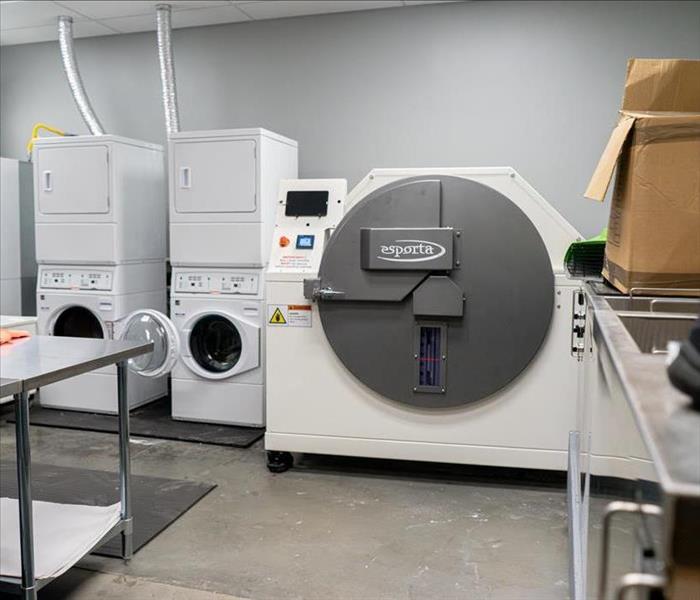 Content restoration equipment at the Shaw HQ
Content restoration equipment at the Shaw HQ
A fire can be one of the most devastating events for any home or business owner. Beyond the immediate damage caused by flames, smoke and soot can leave long-lasting effects that require professional restoration. SERVPRO® of Lake Conroe, Cleveland, and Magnolia specializes in fire damage restoration, helping property owners rebuild and restore their spaces quickly.
The Dangers of Fire Damage Beyond the Flames
Even after a fire is extinguished, the damage continues. Here’s what property owners need to be aware of:
- Smoke Residue: Smoke particles can settle deep into walls, carpets, and furniture, creating persistent odors and potential respiratory hazards.
- Soot Corrosion: Soot from fires is highly acidic and can cause permanent damage to surfaces, including metal, glass, and electronics.
- Water & Chemical Damage: The water used to extinguish the fire can cause additional damage, leading to mold growth if not properly dried.
- Weakened Structural Integrity: Fire can weaken the structure of a home or business, making it unsafe to enter until properly assessed.
What to Do After a Fire
Ensure Everyone’s Safety
Once the fire is out, wait for clearance from fire officials before re-entering the property. Smoke inhalation and structural instability can pose serious risks.
Document the Damage
Take photos and make a list of damaged items for insurance claims. This will help speed up the process of getting financial assistance for repairs.
Avoid Cleaning Soot Yourself
Soot spreads easily and can become embedded in fabrics and porous materials. Using improper cleaning methods can cause more harm than good.
Call a Professional Fire Damage Restoration Service
SERVPRO® of Lake Conroe, Cleveland, and Magnolia has the expertise to clean up fire damage, remove smoke odors, and restore your property efficiently.
Our Fire Damage Restoration Services
- Soot and Smoke Removal: Using specialized techniques, we remove all traces of soot from walls, ceilings, and surfaces.
- Odor Elimination: We use industrial-grade air scrubbers and ozone treatments to eliminate smoke odors.
- Structural Repairs: From drywall replacement to full reconstruction, we restore damaged areas to their pre-fire condition.
- Content Cleaning: We clean and restore salvageable furniture, electronics, and personal items affected by smoke.
Recovering from a fire can feel overwhelming, but SERVPRO® of Lake Conroe, Cleveland, and Magnolia is here to help. Contact us for fast, professional fire damage restoration services.
Clearing the Air: The Role of Deodorization in Fire Damage Restoration
12/15/2023 (Permalink)
After a fire, the visible damage is evident, but the lingering odors can be equally distressing. Let's explore why deodorization is an essential step in the restoration process and how it can make a significant difference in your home's recovery.
Understanding the Impact of Smoke Odor
When a fire occurs, it leaves behind not only charred remnants but also a pervasive, stubborn smoke odor. This odor can penetrate porous surfaces, materials, and even HVAC systems, making it challenging to remove. Smoke odors are not only unpleasant but can also pose health risks, making their elimination paramount.
The Importance of Prompt Deodorization
Lingering smoke odors may contain harmful particles and chemicals that can adversely affect your health. Proper deodorization reduces these risks, creating a healthier living environment.
Smoke odors can also decrease the resale value of your home and make it less appealing to potential buyers. Deodorization is a smart investment that helps maintain or even increase your property's value.
The Deodorization Process
- Assessment: Our trained professionals start by assessing the extent of smoke odor damage. This step is crucial to determine the appropriate deodorization methods.
- Cleaning: Thorough cleaning is essential to remove soot and other residues that may be contributing to the odor problem.
- Ozone Treatment: Ozone generators can neutralize odor molecules, effectively eliminating the smell. These generators should be used by trained professionals to ensure safety and effectiveness.
- Thermal Fogging: This process involves using a heated fog to penetrate and neutralize odors in hard-to-reach areas.
- Sealants: In some cases, sealing surfaces can prevent odors from re-emerging, providing long-term protection.
- HVAC Cleaning: Smoke odors can infiltrate your HVAC system, so it's essential to clean and deodorize the ductwork.
Deodorization is a critical aspect of fire damage restoration, one that should not be overlooked. Its impact on your health and property value cannot be overstated. When facing the aftermath of a fire, professional deodorization can make your home safe, comfortable, and inviting once more.
SERVPRO® of Lake Conroe is here to assist you throughout the fire damage restoration process, including comprehensive deodorization. If you're in need of expert guidance and assistance, don't hesitate to contact our local SERVPRO® professionals. We're here to help you reclaim your home and your peace of mind.
Fire Safety in the Workplace: A Comprehensive Guide to Preparing Your Business for Potential Fires
8/16/2023 (Permalink)
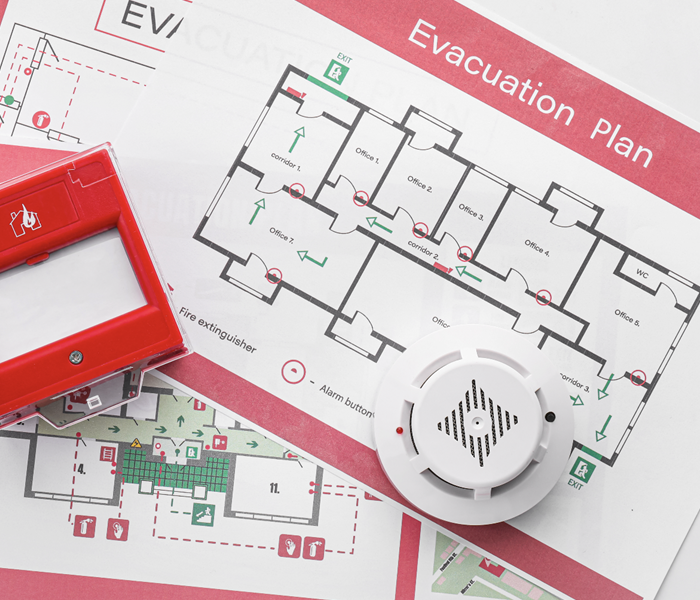 Have a evacuation plan in place to reduce the risk of injury in your business.
Have a evacuation plan in place to reduce the risk of injury in your business.
Fires are unpredictable and can have devastating consequences for businesses. From property damage to financial losses and potential harm to employees and customers, the impact of a fire can be far-reaching. That's why it's crucial for business owners to take proactive measures to prepare for a fire and minimize the risks associated with such an event. In this blog post, we will provide you with a step-by-step guide on how to prepare your business for a fire, ensuring the safety of everyone involved and the continuity of your operations.
Conduct a Fire Risk Assessment
Start by assessing the fire risks specific to your business and premises. Identify potential ignition sources, flammable materials, and areas of concern. Evaluate your emergency evacuation routes, fire alarms, fire extinguishers, and any other fire safety equipment. A comprehensive fire risk assessment will serve as the foundation for your fire preparedness plan.
Develop a Fire Safety Plan
Based on the findings of your fire risk assessment, create a detailed fire safety plan for your business. Include information on emergency procedures, evacuation routes, assembly points, and designated roles and responsibilities for employees during a fire. Ensure the plan is easily accessible to all employees and conduct regular training sessions to familiarize them with the procedures.
Install and Maintain Fire Safety Equipment
Ensure that your business is equipped with appropriate fire safety equipment, including smoke detectors, fire extinguishers, fire sprinklers, and fire blankets. Regularly inspect and maintain this equipment to ensure it is fully operational. Consider partnering with a professional fire safety company to conduct inspections and perform necessary maintenance.
Implement Fire Prevention Measures
Put preventive measures in place to reduce the risk of fire in your business. This can include proper storage and handling of flammable materials, regular equipment maintenance and inspection, and implementing smoking policies in designated areas. Educate your employees about fire prevention measures and encourage them to report any potential fire hazards.
Develop an Emergency Communication Plan
Communication is crucial during a fire emergency. Establish a clear and efficient communication plan that includes methods of notifying employees, emergency services, and relevant stakeholders. Designate individuals responsible for initiating emergency communications and ensure they are trained on the protocols.
Conduct Regular Fire Drills
Regularly practice fire drills with your employees to ensure they are familiar with evacuation routes and procedures. These drills will help identify any gaps or areas for improvement in your fire safety plan. After each drill, conduct a debriefing session to discuss any issues and make necessary adjustments to your plan.
Review and Update Your Fire Preparedness Plan
Your fire preparedness plan should be a living document that is regularly reviewed and updated. As your business evolves or as regulations change, ensure that your plan reflects these updates. Keep abreast of the latest fire safety practices and protocols to ensure that your business remains prepared for any fire-related event.
By following these steps and prioritizing fire preparedness, you can significantly reduce the risks associated with a fire and increase the safety of your business and everyone within it. A well-prepared business will not only protect lives and property but will also be better equipped to recover and resume operations in the event of a fire. Remember, fire preparedness is an ongoing effort that requires regular attention and updates to ensure its effectiveness.
Lint Be Gone: A Step-by-Step Guide to Cleaning Your Dryer Vent and Improving Safety
4/10/2023 (Permalink)
 SERVPRO can help clean your dryer vent and prevent potential fires
SERVPRO can help clean your dryer vent and prevent potential fires
As a homeowner, it's important to take care of your appliances to ensure they are functioning properly and safely. One appliance that is often overlooked when it comes to maintenance is the dryer. Specifically, the dryer vent is an important component that should be cleaned regularly to prevent potential hazards. In this blog, we'll discuss when you should clean your dryer vent and the benefits of doing so.
First and foremost, it's important to understand what the dryer vent does. The dryer vent is responsible for removing hot, moist air from the dryer and directing it outside. Over time, lint and other debris can build up in the vent, causing it to become clogged. This can lead to a number of hazards, including fire, carbon monoxide poisoning, and reduced efficiency of the dryer.
When should you clean your dryer vent?
The answer depends on a few factors. As a general rule of thumb, it's recommended to clean your dryer vent at least once a year. However, if you notice any of the following signs, it may be time to clean your dryer vent sooner:
- Your clothes are taking longer to dry than usual.
- You notice a burning smell when the dryer is running.
- The outside of the dryer feels hot to the touch.
- You see an excessive amount of lint accumulating around the outside vent.
If you notice any of these signs, it's best to clean your dryer vent as soon as possible to prevent any potential hazards.
There are a few benefits to cleaning your dryer vent regularly. The first is increased safety. A clogged dryer vent can lead to a fire damage in your home. Regular cleaning can prevent these hazards and keep your home and family safe.
Improved efficiency
Another benefit of cleaning your dryer vent is improved efficiency. When the vent is clogged, the dryer has to work harder to dry your clothes, which can increase your energy bills and reduce the lifespan of your dryer. Cleaning the vent can improve the efficiency of the dryer, saving you money in the long run.
Air Quality
In addition to these benefits, cleaning your dryer vent can also improve the air quality in your home. When the vent is clogged, it can lead to a buildup of mold and other allergens, which can exacerbate allergies and other respiratory problems.
In conclusion, it's important to clean your dryer vent regularly to prevent potential hazards and improve efficiency. As a general rule of thumb, it's recommended to clean your dryer vent at least once a year. However, if you notice any signs of a clogged vent, it's best to clean it as soon as possible. Regular cleaning can increase safety, improve efficiency, and improve air quality in your home. Give SERVPRO a call to help clean your dryer vent and prevent future fires to your property.
Potential Kitchen Hazards
2/16/2023 (Permalink)
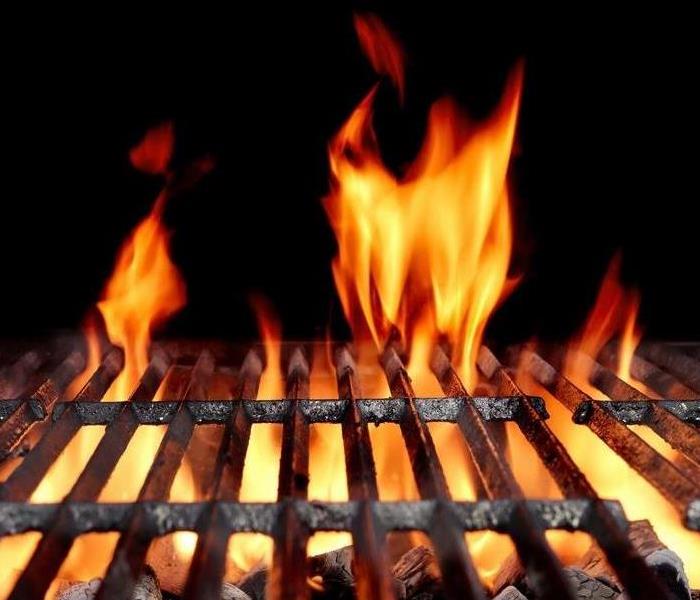 When your in need of fire restoration cleanup, give SERVPRO of Lake Conroe a call today!
When your in need of fire restoration cleanup, give SERVPRO of Lake Conroe a call today!
If you're in charge of your kitchen, you know how important it is to keep an eye out for potential hazards. You don't want to have a fire or any other kind of emergency situation that will force you out of your home. There are many things that can go wrong in kitchens from grease fires to faulty appliances There's plenty of room for disaster if you're not careful. However, there are also many easy ways to prevent these problems from occurring at all.
Dirty floors
Cleaning your kitchen floor is an important part of preventing a slip and fall accident. Dirty floors are a common cause of slips and falls, so it's important to keep your kitchen floor clean at all times.
Clean up spills immediately before they have time to dry and stick to the floor. If you can't clean up the spill immediately, use something absorbent like paper towels or a sponge to soak up as much liquid as possible.
Food on the Stove Unattended
A fire hazard is something that could ignite and spread flames. In the kitchen, this can be caused by leaving food unattended on the stove or in the oven. You might think that you'll only be gone for a few minutes, but it doesn't take long for something to get out of hand. For example, if you leave bacon frying without checking on it every few minutes and it burns instead of browning.
Combustible Cooking Materials
If you're still using a gas stove, it's important to know that combustible cooking materials can be flammable. This means they can catch fire and, if left unattended, start a fire without any outside help.
The most common materials in this category are paper products such as napkins and paper towels, kitchen towels Other common combustible cooking materials include wood chips for smoking meats, wicker baskets for use with hot food items like fried chicken wings or French fries, and wooden spoons or spatulas used for stirring foods on the stovetop.
Grease fires
Grease fires are the most common type of kitchen fire. In fact, these types of fires account for about two-thirds of all deaths related to home cooking.
Grease fires can be caused by cooking or heating, but also by using a candle or match as a light source. They can spread quickly and cause serious damage if left unattended. Keep your kitchen clean and organized so that grease doesn't build up on your stovetop or in other places where it could start a fire.
Broken Dishwasher Seals
Dishwasher seals are an important part of your dishwasher. They keep water and food particles from getting into the motor, but over time they can wear out and break. Dishwashers can cause water damage which could leave you without.
Bad Ventilation System
A ventilation system in your kitchen should be designed to remove smoke and fumes from the kitchen. In addition to this primary function, it should have the ability to prevent backdrafts, carbon monoxide poisoning and fire.
The best way to prevent all these things is by maintaining your smoke alarm system regularly. This will ensure that you can quickly respond if there’s ever a problem with your ventilation system or any other safety feature in your home.
Poor Lighting
Poor lighting can cause accidents, injuries, falls and burns. Poor lighting can also result in damage to your eyes and skin. Accidents may happen if there is not enough visibility in the room, which can cause trip and fall hazards leaving you with injuries.
Use the following tips to help prevent kitchen hazards in your home or business. Ensure you area is safe and secure for yourself or employees.
3 Tips To Prevent Home Candle Fires
12/2/2022 (Permalink)
 A battery-powered option takes away the risk of fire.
A battery-powered option takes away the risk of fire.
Prevent Home Candle Fires
People often light a candle at home to enjoy the warming scent it gives off, but overlook the risk of starting a fire in their home. Candles are one of the most common causes of a residential fire. Luckily, there are steps you can take to prevent one in your Magnolia, TX, home.
1. Avoid Nighttime Burning, the Biggest Candle Fire Cause
Many will light a candle to help them relax after a long day, but this can lead to a dangerous home fire if neglected. Nighttime candle burning is risky if you happen to fall asleep while the flame's still aglow, or go to bed without remembering to blow out the candle. It's best to avoid nighttime burning altogether to alleviate this risk.
2. Keep Candle Away From Anything That Might Burn
A majority of candle fires happen as a result of flammable items surrounding the candle. This can lead to quick destruction of a home and require the help of a fire damage restoration company to perform smoke cleanup and structural repairs. Be sure to keep any lit candle a safe distance away from items that could burn, such as paper documents, cloth or flammable liquids.
3. Opt for a Flameless Alternative
The foolproof way to avoid a candle fire is to use a flameless alternative. If you use candles for ambiance, a battery-powered option takes away the risk of fire. Additionally, don't rely on candles for light in an emergency power outage but stock up on flashlights instead. These alternatives can best keep your home and family safe from a potential fire.
A candle fire is more common than you think but luckily can be avoided by taking smart, preventative measures. Keep your home safe by avoiding burning at night, keeping candles away from flammable items and choosing a flameless alternative.
Why You Should Frequently Clean Your Dryer Vent To Prevent a Fire
11/2/2022 (Permalink)
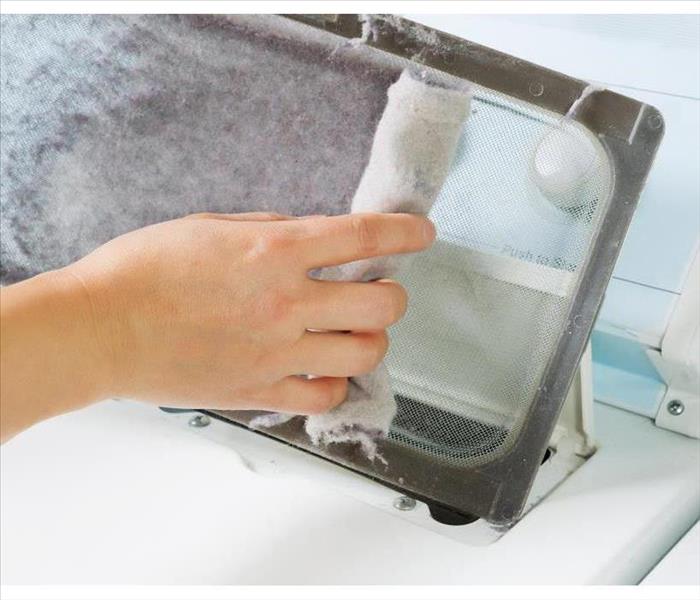 Clean your dryer's lint filter after every load of laundry.
Clean your dryer's lint filter after every load of laundry.
Why Should You Clean Your Dryer Vent Frequently To Avoid a Fire?
Every household should take preventative measures to avoid a home fire. But one leading cause that often goes overlooked is an unclean dryer vent. Material buildup and high heat from the dryer can result in a lint fire. Here's what you should do to prevent one from happening in your Splendora, TX, home.
Routinely Clean Dryer To Prevent a Lint Fire
The lint from your clothes will collect during the drying process and without proper removal, there is a risk of a dryer fire starting. Be mindful of this every time you put a load of laundry into the dryer and get into the habit of regular cleaning. This includes:
- Cleaning the dryer's lint filter after every load of laundry
- Reaching into the back of the dryer where lint can also collect
- Remove lint from the vent pipe roughly every three months
This routine cleaning can be done yourself or you can also enlist a professional, particularly if you notice your clothes are taking longer to dry.
Check Dryer Maintenance
Proper maintenance checks will keep your dryer running safely and effectively. Inspect areas around the dryer for potential fire hazards, including a damaged vent system, animal nests blocking a vent and any flammable items placed nearby.
Understand Dryer Safety Practices
A lint fire can cause severe damage to your Splendora, TX, home and often require the help of a fire damage restoration company afterward. Practice safe measures to limit your risk of a drying machine fire. These include not drying items containing plastic, rubber, foam or anything that has come in contact with a flammable liquid, not using your dryer without a lint filter and not leaving the house with the dryer running.
Be sure to perform regular cleaning and maintenance checks on your dryer along with using safe practices to prevent a fire in your home.
Equipment You Can Use To Remove Smoke Odor in Your Home
9/30/2022 (Permalink)
 Ozone machines are often used in the process of smoke cleaning.
Ozone machines are often used in the process of smoke cleaning.
Remove Smoke Odor in Your Home
Removing smoke in your home in Splendora, TX, after it has been damaged by a fire can be a difficult, time-consuming process, and even after scrubbing and cleaning, the smell of smoke may still be present. However, with the right equipment, smoke cleaning can be simple and effective.
1. Air Filtration Devices
There are a wide variety of air filtration devices that are often used after a home has been impacted by a fire. Air filtration devices help to make the air in the home safe to breathe and can also lessen the smell of smoke simultaneously. Many of these devices use HEPA (high-efficiency particulate air) filters in their machines because HEPA filters are able to capture small particles out of the air.
2. Ozone Machines
Ozone machines are often used in the process of smoke cleaning because the machines are incredibly effective. First, the ozone machine is placed in the area that has been affected by smoke. Large homes may require the use of more than one ozone machine. These machines change the makeup of smoke particles through oxidation. As a result, the smell of smoke can be eliminated.
3. Thermal Foggers
Thermal foggers are specialized pieces of equipment that can help to assist in removing smoke odor throughout the home. Fogging involves, as the name suggests, a fog being released into the area that has smoke damage. The fog particles can reach into small places, such as in minuscule cracks, in the same manner that smoke particles can reach into such places. The fog is then able to neutralize the odor of smoke.
Using equipment such as air filtration devices, ozone machines and thermal foggers can make the process of smoke cleaning less labor-intensive. Some homeowners whose houses have been damaged by fires find it useful to get in touch with fire and smoke damage restoration experts when they are unsure about neutralizing odors.
Purchasing the Correct Fire Extinguisher for Your Home
8/24/2022 (Permalink)
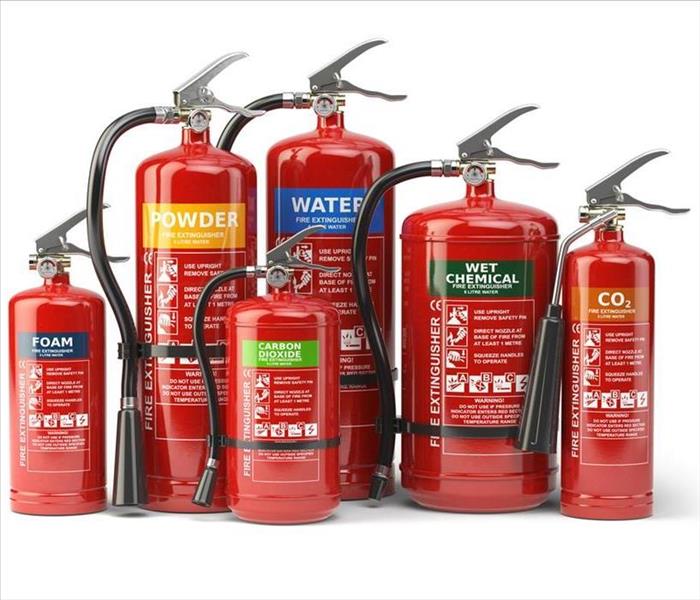 Purchase the correct fire extinguisher
Purchase the correct fire extinguisher
Types of Fire Extinguishers
When choosing the right fire extinguisher for different areas of your home/garage, consider the class. Consider the size and power of the fire extinguisher as well. Larger extinguishers may have more power, but if you physically cannot lift nor control the extinguisher, it won't do much good.
There are four classes of fire extinguishers – A, B, C and D – and each class can put out a different type of fire.
Class A fire extinguishers
Class A fire extinguishers are used for ordinary combustibles, such as paper, wood, cloth, and some types of plastic. These extinguishers typically use water or certain types of dry chemicals to either absorb heat or coat the fire.
Class B fire extinguishers
Fires that originate from flammable liquids and gas can be extinguished by a class B fire extinguisher. This is the type of extinguisher you’ll want to use on a fire caused by oil or fuel.
Class C fire extinguishers
Class C fire extinguishers are effective against electrical fires from live wires, panels, and circuit breakers. The extinguisher works by releasing materials that stop the conduction of electricity.
Class D fire extinguishers
Class D fire extinguishers are used on combustible metals. These include magnesium, sodium, aluminum, and titanium.
Class K fire extinguishers
Commonly used in restaurant kitchens, class K fire extinguishers can effectively put out fires caused by cooking fats, greases, and oils. They use a process called saponification by releasing an alkaline agent to create a foam that traps vapors and puts the fire out.
Purchasing your fire extinguisher
Now that you know how many extinguishers you need and what types to get, you can head to the hardware store. Look for fire extinguishers that you can easily lift and handle.
Grill Cleaning Keeps Your Backyard Meals Tasting Great
5/27/2022 (Permalink)
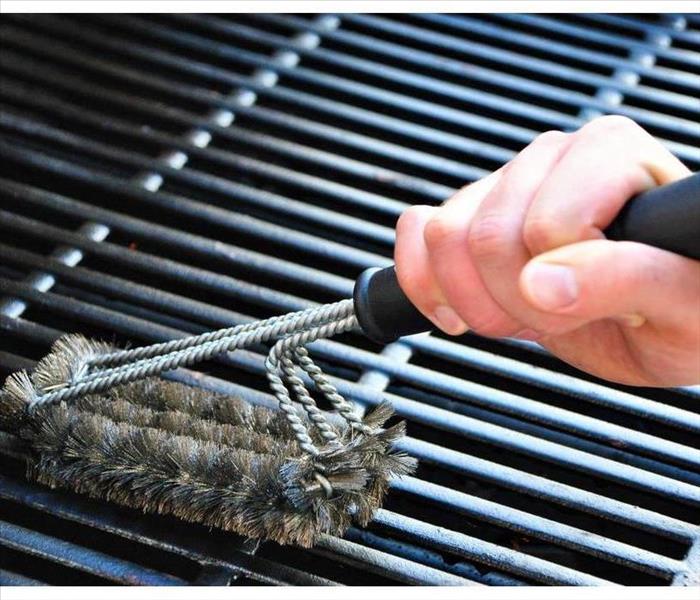 Grill cleaning is a relatively easy task that pays off with better-tasting food.
Grill cleaning is a relatively easy task that pays off with better-tasting food.
Grill Cleaning
An outdoor grill is a convenient and delicious way to prepare meals in Willis, TX. To get the best flavor, you'll need to clean your grill from time to time. Grill cleaning also keeps it performing at its best and reduces the risk of a grease fire. You can clean your grill in a few easy steps.
Gather Supplies
Before you begin, you'll need to get your supplies together:
- Grill brush
- Paper towels
- Dish soap
- Aluminum foil
- Bucket
- Work gloves
- Garden hose
Start with a warm grill and make sure all knobs are in the off position. Disconnect the propane tank.
Begin Cleaning
Remove the grill grates and metal plates and soak them in a bucket of hot, soapy water. While they soak, cover the heating elements with foil. Use the grill brush to remove carbon buildup on the underside of the hood and grill walls. Use a damp paper towel to wipe the surfaces clean.
Continue your grill cleaning by emptying the drip pan over a trash can. When it's empty, soak the pan in the bucket. Remove the metal plates and grill grates. Scrub them clean with the grill brush and spray them with the hose.
Remove the foil and clean the heating elements with the grill brush, then remove the drip pan from the bucket and rinse it. Replace all items and reconnect the propane tank.
Enjoy Your Clean Grill
Grill maintenance helps you avoid the risk of a fire that could lead to damage and the need for emergency restoration services. To use your grill safely, always stay near it while you're cooking and keep children and pets away. Your grill should be kept away from the house, out in the open, where there are no overhead obstructions like low branches.
Grill cleaning is a relatively easy task that pays off with better-tasting food. It also gives you peace of mind as you prevent the risk of fire.
3 Ways to Know How Many Fire Alarms You Need
2/20/2022 (Permalink)
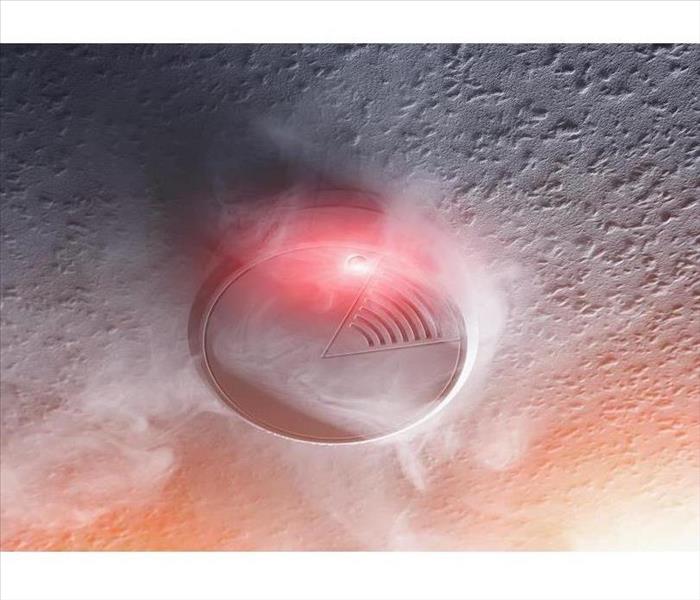 According to the NFPA you should have smoke alarms in every room.
According to the NFPA you should have smoke alarms in every room.
Most homeowners know that a smoke detector and a fire alarm are mainstays of keeping your home safe from disaster, but knowing how many you should have to be safe is another issue entirely. Is one per room enough? Read on to get pointers on how to protect your Cleveland, TX, home from fire damage with the proper number of alarms.
Types of Fire Detectors and Alarms
It may come as a surprise, but every fire sensor is not the same. The main options for protecting your home from fire include:
- Heat detectors, which include an element activated when a fixed temperature is reached
- Smoke alarms, which work by using special technology that reacts to the ions in high levels of smoke
Smoke detectors are among the most common and effective residential fire protection devices, but they’re only useful if they’re applied properly.
How Many Rooms Do You Have?
According to the National Fire Protection Association, you should have smoke alarms in every room, outside each sleeping area and on every level of the home. For a two-story, three-bedroom house, that means you’ll need at least five to be safe.
How Big Is Your Home?
On average, a smoke detector will cover about 900 square feet. Additionally, experts advise installing a fire alarm every 30 feet in straight runs, meaning a hallway or large, unobstructed room. Some states have specific requirements, so it’s worth it to do your research in addition to using this rule of thumb.
Don’t Forget the Basement
While it’s often an afterthought, especially if it’s unfinished, the basement of your home is just as susceptible to fire and smoke damage as any other room. Make sure your fire protection plan includes installing devices here.
Fortunately, a simple fire alarm is affordable and readily available, but you must know how to use one for it to work. Follow the above rules of thumb from fire damage experts to keep your home safe and secure.



 24/7 Emergency Service
24/7 Emergency Service









